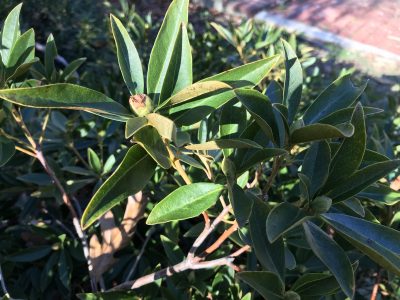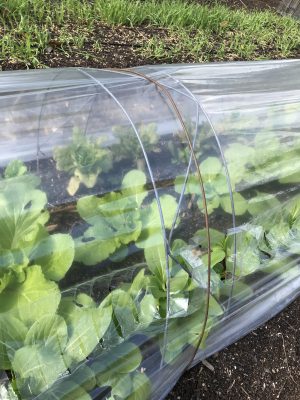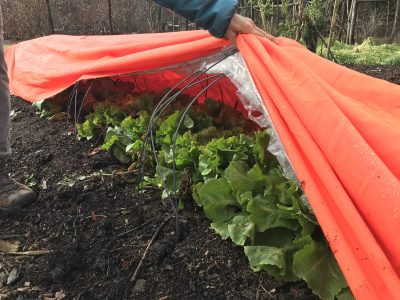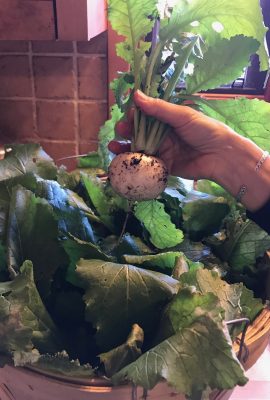Mystery Solved, and Frigid Dealings
Mystery Plant: No longer a Mystery
Last week I mentioned my brother’s mystery shrub, which he wanted to prune back heavily. I told him it was okay to do so even though I — and a number of experts I consulted — could not identify the plant.
(Drum roll . . .) The plant has finally been identified, by Mark Brand of the University of Connecticut, as Wilson rhododendron, Rhododendron x laetevirens. I had narrowed it down to R. carolinianum, which is one of the parents of this hybrid, the other being R. ferrigineum.

Wilson rhododendron flower bud
My brother’s not noticing flowers on this rhododendron is understandable. It’s a super cold hardy but sparse bloomer that’s grown mostly for its foliage; the pointy leaves don’t droop or curl, but remain perky, even in frigid weather.
Now I can sleep nights.
It was Cold Outside!
Talk about frigid weather: I was surprised at how cold it was on the farmden during my Thanksgiving visit to my bro’ in Rhode Island. The night of Friday, November 23rd, New Paltz weather reported a low of 7° F. Brrrrr. As I’ve mentioned before, I live in a valley. Cold air, which is heavier than warm air, sinks into low spots, bringing the temperature right out in my garden even lower, down to 3° F.
(I knew this even when in Rhode Island, thanks to Sensorpush, a nifty device that transmits minute by minute temperature and humidity conditions to my cell phone from wherever the device is located.)
It’s all about microclimates, which are localized differences from the general climate due to such influences as heat-absorbing masonry walls and paths, which keep temperatures warmer in winter. Or nearby bodies of water, which keep temperatures warmer in winter and cooler in summer. Or differences in elevation, lowering the temperature 6°F for every 1000 feet of elevation, and low lying areas.
Lower temperatures with elevation might seem contradictory to the locally colder temperatures in my garden that night. These colder temperatures occur only when still windless air and a clear sky let any heat the ground has accumulated by day re-radiate back to the heavens. A cloudy night or tree cover would reflect that re-radiated heat back downwards, preventing the cooling. With radiative cooling, air near the ground is coldest, and and warmer air hovers higher up.
Microclimate Adjustment=Fresh Salad Greens
As a gardener, I can play around with microclimate and have it work for me, as evidenced from the fresh endive, winter radishes, lettuce, and turnips just harvested from right out in the garden.
Preparation for that harvest began in late summer with spreading compost in the bed and the sowing of endive seeds. I planted turnip, lettuce, and winter radish seeds in the bed in September.
Back in early October I spaced metal hoops 4 feet apart along the bed, each one spanning from one side to the other of the bed. Later on in October, I covered the hoops with a length of clear plastic, slitted row cover creating a tunnel over the bed. The slits keep the interior of this mini-greenhouse from overheating.
Moving into November, temperatures gradually cooled but still not enough to threaten the covered plants. Between the plants natural cold hardiness and the cover, I figured they were fine into the low 20s. (For more on microclimates and their manipulation, see my new book The Ever Curious Gardener.)
Short days and low hanging sun, coupled with cool temperatures, were not providing conditions for plant growth. But the plants were, by then, fully grown, so no more growth was needed. At that point I laid a cloth cover over the tunnel to keep out further depths of cold. Light became immaterial; I just wanted the plants alive and fresh.
And so they have remained, even after temperatures plummeted to 3°.
Not only are the plants alive and fresh. Cold temperatures have brought out the best in their flavor. The veggies are crisp, sweet, and tangy.


Curious about your SensorPush – where do you house it outside? It sounds as though this is a wireless device so I’m assuming you didn’t get readings WHILE you were in RI? I’ve never been quite happy with my weather device and am always looking for new recommendations.
The outdoor Sensorpush is hanging on a nail on one of the posts of around the vegetable garden. I made a small cover just to keep direct rain out. I highly recommend this device. Yes, I got the readings while I was in RI. I get them on my iPhone no matter where in the world I am, as long as I have web access. Temperature and humidity data are recorded and stored as hour, day, week, month, or year, all of which can be downloaded to a computer. Check out the website, http://www.sensorpush.com
Love these posts! I’m surprised kale wasn’t in this lineup. Not cold hardy enough, or are you not as big a fan of it?
My oversight. Of course kale survived under the tunnel. If the outdoor kale hadn’t been eaten, it probably would have survived also.
Wonderful post, Lee. Thank you! I never quite get the winter veggies in – except for some leeks I overwintered last year. You inspire me to be a better winter vegetable gardener next year.